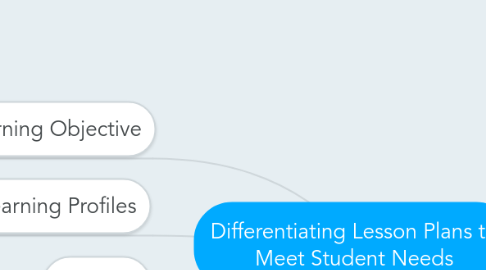
1. Learning Objective
1.1. (SWBAT) identify evidence from diverse sources, with respect to content, authorship, purpose, format, and audience.
2. Learning Profiles
2.1. Definition
2.1.1. Every student learns differently. An individual’s learning style refers to the preferential way in which the student absorbs, processes, comprehends and retains information.
2.2. Example 1: Visual Learners
2.2.1. Visual learners attend to information most effectively when ideas, concepts, data, and other information are associated with images and techniques such as pictures, diagrams, films and videos or demonstrations.
2.2.1.1. Use graphic organizers, charts, videos to differentiate instruction.
2.3. Example 2: Auditory Learners
2.3.1. An auditory learner depends on hearing and speaking as a main way of learning.
2.3.1.1. Use group discussions and presentations to differentiate instruction.
2.4. How to identify students' needs
2.4.1. 1. Learning Style Survey: 20 questions tailored to identifying learning styles.
2.4.2. 2. Students' observations: know my students’ interests because interests can help in identifying what they like to do and point to a specific learning style, read how students try to find a solution (listening/talking for auditory, using their hands for kinesthetic, using their eyes for visual).
3. Interests
3.1. Definition
3.1.1. Teacher tries to make connections with experiences students already find appealing, intriguing, relevant and worthwhile.
3.2. Example 1: Video Games
3.2.1. Product Differentiation: Students’ choice (example: RAFT) and Content Differentiation: Make it relevant to the students’ interests (example: interest groups)
3.3. Example 2: Sports
3.3.1. Product Differentiation: Students’ choice (example: RAFT) and Content Differentiation: Make it relevant to the students’ interests (example: interest groups)
3.4. How to identify students' needs
3.4.1. 1. First day questionnaire. On the first day of school, I ask my students about 30 open-ended questions to get to know them. Most of the questions revolve around interests (what they like to do, read, listen to, etc).
3.4.2. 2. Truth Statements. Ask students to write a one sentence "truth statement" about an upcoming unit topic. It's a simple way to find out what they find interesting or not.
4. Readiness
4.1. Definition
4.1.1. Instruction should begin where the student's skill level currently exists. Readiness uses formative assessments to find and evaluate the gaps between student understanding and learning targets at a lesson and unit level.
4.2. Example 1: One ELL student who is at the speech emergent level.
4.2.1. Content Differentiation: front loading academic vocabulary, provide text digests or summaries to support comprehension.
4.2.2. Product Differentiation: Tiered assignments, Choice Boards, Tic-Tac-Toe.
4.3. Example 2: One ELL student who is at the near fluency level.
4.3.1. Product Differentiation: Tiered assignments, Choice Boards, Tic-Tac-Toe.
4.3.2. Process Differentiation: Think-Pair-Share, Jigsaw, Cubing
4.4. How to identify students' needs
4.4.1. 1. Diagnostic evaluations (pre-test) at the beginning of each unit.
4.4.2. 2. K-W-L Chart at the beginning of each unit.
